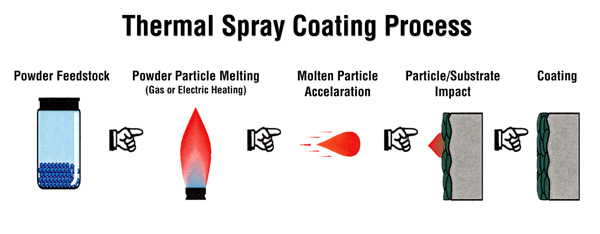What is Thermal Spraying
What is Thermal Spraying

Thermal spray is a group of coating processes in which melted (or heated) materials are sprayed onto a prepared surface. The coating material or "feedstock" is heated by electrical (plasma or arc) or chemical means (combustion flame). Thermal spray coatings can be thick (thickness range from 20 micrometers to several mm).
Thermal Spray Coating materials for thermal spray include metals, alloys, ceramics, plastics, and composites. They are fed in powder or wire form, heated to a molten or semi-molten state, and accelerated towards substrates in the form of micrometer-size particles. Combustion or electrical arc discharge is usually used as the source of energy for thermal spraying. The resulting coatings are made by the accumulation of numerous sprayed particles. The surface may not heat up significantly, allowing the coating of flammable substances.

Thermal Spray Coating quality is usually assessed by measuring its porosity, oxide content, macro and micro-hardness, bond strength, and surface roughness. Generally, the coating quality increases with increasing particle velocities.
Types of the thermal spray :
1. Plasma spray (APS)
2. Detonation Gun
3. Wire arc spraying
4. Flame spray
5. High-velocity oxygen fuel (HVOF)
6. High-velocity air fuel (HVAF)
7. Cold spray
Applications of Thermal Spraying
Thermal spray coatings are extensively used in manufacturing gas turbines, diesel engines, bearings, journals, pumps, compressors, and oil field equipment, as well as in coating medical implants.
Thermal spraying is principally an alternative to arc welded coatings, although it is also used as an alternative to other surfacing processes, such as electroplating, physical and chemical vapor deposition, and ion implantation for engineering applications.
The Benefits of Thermal Spraying
1. Comprehensive choice of coating materials: metals, alloys, ceramics, cermets, carbides, polymers, and plastics;
2. Thick coatings can be applied at high deposition rates;
3. Thermal spray coatings are mechanically bonded to the substrate - can often spray coating materials that are metallurgically incompatible with the substrate;
4. Can spray coating materials with a higher melting point than the substrate;
5. Most parts can be sprayed with little or no preheat or post-heat treatment, and component distortion is minimal;
6. Parts can be rebuilt quickly and at low cost, and usually at a fraction of the price of a replacement;
7. By using premium material for the thermal spray coating, the lifetime of new components can be extended;
8. Thermal spray coatings may be applied both manually and mechanized.





















